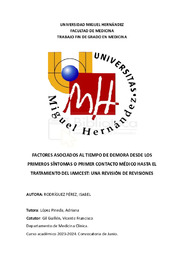Por favor, use este identificador para citar o enlazar este ítem:
https://hdl.handle.net/11000/35573Factores asociados al tiempo de demora desde los primeros síntomas o primer contacto médico hasta el tratamiento del IAMCEST: una revisión de revisiones
| Título : Factores asociados al tiempo de demora desde los primeros síntomas o primer contacto médico hasta el tratamiento del IAMCEST: una revisión de revisiones |
| Autor : Rodríguez Pérez, Isabel |
| Tutor: López Pineda, Adriana Gil Guillén, Vicente Francisco |
| Editor : Universidad Miguel Hernández |
| Departamento: Departamentos de la UMH::Medicina Clínica |
| Fecha de publicación: 2024-05-04 |
| URI : https://hdl.handle.net/11000/35573 |
| Resumen : Introducción: La cardiopatía isquémica es la principal causa de muerte en los países desarrollados, representando el IAMCEST la manifestación más aguda de la enfermedad coronaria. Una demora en la aplicación del tratamiento es uno de los factores que influyen directamente en la mortalidad, siendo de elección la intervención coronaria percutánea primaria. El tiempo de demora desde el inicio de los síntomas hasta la implantación del balón y el tiempo puerta-balón, entre otros tiempos de demora existentes, pueden verse alterados por múltiples factores que pretenden estudiarse con esta revisión de revisiones. Objetivo: Identificar los factores asociados a la demora del tratamiento del IAMCEST desde el primer contacto médico hasta el tratamiento y desde la aparición de los síntomas hasta el tratamiento. Material y métodos: Se realizó una búsqueda en cuatro bases de datos (EMBASE, SCOPUS, MEDLINE y COCHRANE LIBRARY). Dos revisoras de forma independiente revisaron títulos y resúmenes de las revisiones sistemáticas encontradas usando la plataforma Rayyan. Las revisiones seleccionadas fueron descargadas y subidas a la plataforma Rayyan donde dos revisoras valoraron si cumplían los criterios de selección leyendo el texto completo. En ambas fases un tercer revisor resolvió las posibles discrepancias. La búsqueda fue realizada el 26 de diciembre de 2023. Resultados: Se incluyeron un total de 24 revisiones sistemáticas publicadas desde 2012 hasta 2023. El 60% de las revisiones combinan estudios experimentales y observacionales . La población estudiada fueron adultos con IAMCEST. En un 29% de los estudios se evalúa la influencia del COVID COVID-19 en el tiempo de demora, en un 20% la realización de triaje triaje-ECG prehospitalario, en un 12,5% el sexo, y, en menores porcentajes, la presentac ión fuera del horario laboral habitual, la hipotermia terapéutica , la activación p rehospitalaria de la sala de hemodinámica, el tipo de acceso para ICP y otros factores. E El tiempo puerta puerta-balón se analizó en más del 90% de los estudios, seguido del tiempo de síntomas a balón (tiempo total de isquemia) en el 30%. La mayoría de las revisiones realizaron metaanálisis de los datos obtenidos. Conclusión: La presencia de COVID COVID-19 concomitante, la presentación durante la pandemia, la terapia con hipotermia y el sexo femenino aumentan el tiempo de demora . En cambio, el uso de ECG prehospitalario y la activación prehospitalaria de la sala de hemodinámica lo reducen reducen. La presentación fuera del horario laboral habitual y la elección del tipo de acceso para ICP se consideraron indiferentes indiferentes. Background: Ischemic heart disease is the leading cause of death in developed countries, with STEMI being the most acute manifestation of coronary disease. A delay in the application of treatment is one of the factors that directly influence mortality, with primary percutaneous coronary intervention being the preferred option. The delay time from the onset of symptoms to balloon and door-to-balloon time, among other existing delay times, can be altered by multiple factors that aim to be studied with this umbrella review. Objective: To identify the factors associated with the delay of STEMI treatment from the first medical contact to treatment and from the onset of symptoms to treatment. Material and methods: We searched four databases (EMBASE, SCOPUS, MEDLINE, COCHRANE LIBRARY). Two reviewers independently reviewed titles and abstracts of the systematic reviews found using the Rayyan platform. The selected reviews were downloaded and uploaded to the Rayyan platform, where two reviewers assessed whether the met the selection criteria by reading full text. In both phases a third reviewer resolved possible discrepancies. The search was conducted on 26 December 2023. Results: A total of 24 systematic reviews published from 2012 to 2023 were included. 60% of the reviews combine experimental and observational studies. The population studied were adults with STEMI. In 29% of the studies, the influence of COVID-19 on delay time was evaluated, in 20% the performance of pre-hospital ECG triage, in 12.5% the sex, and, in smaller percentages, the presentation outside normal working hours, hypothermic therapy, pre-hospital activation of the cath lab, the type of access for PCI and other factors. Door-to-balloon time was analyzed in more than 90% of studies, followed by the time from the onset of symptoms to balloon (total ischemia time) in 30%. Most reviews performed meta-analysis of the data obtained. Conclusion: The presence of concomitant COVID-19, the presentation during the pandemic, hypothermic therapy and the female sex increase the delay time. In contrast, the use of prehospital ECG and prehospital activation of the cath lab reduce it. The presentation outside normal working hours and the choice of the type of access for PCI were considered indifferent. |
| Palabras clave/Materias: IAMCEST demora tiempo puerta puerta-balón tiempo total de isquemia ICP |
| Área de conocimiento : CDU: Ciencias aplicadas: Medicina |
| Tipo de documento : info:eu-repo/semantics/bachelorThesis |
| Derechos de acceso: info:eu-repo/semantics/openAccess |
| Aparece en las colecciones: TFG- Medicina |
 La licencia se describe como: Atribución-NonComercial-NoDerivada 4.0 Internacional.
La licencia se describe como: Atribución-NonComercial-NoDerivada 4.0 Internacional.
.png)
